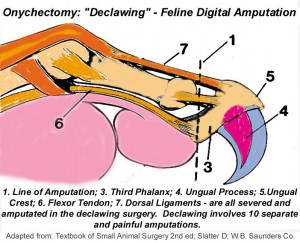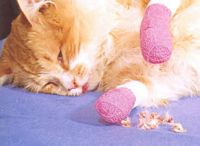Many veterinarians do not explain to cat owners what really occurs in a declawing operation. The procedure is essentially ten complex amputations that are extremely painful following the surgery and can remain painful for the cat. The cat must remain anesthetized for the entire procedure, increasing operative risk. Cats that have been declawed often suffer from prolonged long-term anxiety, stress, depression, and fear. Without claws as their first line of defense to protect themselves, they are sometimes more prone to biting when they are scared.
This movie produced by the Paw Project shows the crippling effects of declawing and the suffering caused by declawing, from a veterinarian’s experience: http://www.pawprojectmovie.com/. Declawing is illegal in a growing number of cities in the U.S., and many veterinarians will not declaw knowing it is amputation of the claws and the whole phalanx, including bones, ligaments, and tendons! The comparison in humans, would be the cutting off of a person’s finger at the last joint of each finger. Contrary to misleading information, declawing is not considered “minor” surgery, it is rather, 10 separate, painful amputations of the distal phalanx at the joint and causes significant pain and suffering that can be ongoing and long-term.

A cat’s claw is a complex digit. It is not just a fingernail as it is with humans. The nails retract and are actuated by muscles and tendons. By cutting into these, you raise the risk of serious long-term physical and emotional impacts for your cat.
Declawed cats in effect are reduced in their ability to gain traction and to walk properly. They have to move with their weight shifted backwards from their natural posture. Claws exist for many reasons:
- To stretch out muscles and spine
- To help exercise and stay fit
- To provide defense against mistreatment or other animals
- To provide traction and grip in all sorts of environments
The consequences of declawing are larger than many people realize. The cat’s behaviors and personality can change dramatically. Declawed cats no longer have their primary defense mechanism and turn to biting as a default behavior. Physical ailments such as premature arthritis, cystitis, or perennial skin disorders can occur. Bungled surgeries can result in growth of deformed claws or serious infection, and long-term pain and suffering.

Some Alternatives to Declawing
- Provide a tall, sturdy, and heavy scratching post or cat tree(s) that you occasionally sprinkle with catnip. There are many varieties of scratchers and trees. Some with carpet and some with sisal rope. All help provide a natural outlet for your cat’s scratching.
- Put shorter cat trees beside the furniture or couch that you want to avoid the cat scratching. The closer the better. Use multiple cat scratchers and trees in the house, not just one.
- There are also now plastic sheathing caps (such as SOFTPAWS) that you can apply to your cat’s front claws that can last for up to six weeks or longer.
- When selecting your household furniture, find closely woven and smooth fabrics. Cats have a hard time piercing tightly woven materials and find smooth fabrics less enticing than rougher surfaces.
- If acclimated to being handled, cats will eventually tolerate or even enjoy having their nails trimmed on a regular basis. It is important to work this into their routine as a positive activity, not as a punishment for scratching. Consult your vet for instructions.
- Until your cat learns the proper locations for scratching (scratchers, toys, etc.), cover unprotected furniture with aluminum foil, double-sided tap, or other materials that discourage him. Many pet supply stores have materials that will help with this.
- When playing with a cat or kitten, it is important to never use your hand or individual fingers as playthings. This teaches the cat that people are toys and she or he may scratch to play. Each time your cat scratches you intentionally, say “OWW” and leave his or her presence. This provides an incentive to stop scratching if they wish to play with you.
- When you find him using the scratcher—praise him like you would your canine friend. Positive reinforcement is everything. If he doesn’t use the right item, don’t scream, hit or throw things. This will only frighten or confuse him. Remember, positive reinforcement is everything. Praise, praise, and more praise!
- If all else fails, get a squirt bottle or squirt gun. When caught in the act—and only when caught in the act—say a loud “NO!” and give him one quick squirt to his body, not his face. You could also shake a rock or marble filled can or drop a magazine on the floor. These methods intrude on where his concentration was, upsets him, and he learns from repetition, that is why praise and love work so well and are the preferred method. Sooner or later, he will get the hint.
- Remember, positive reinforcement is always the key!
